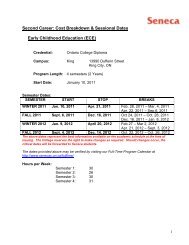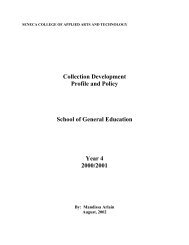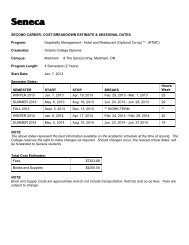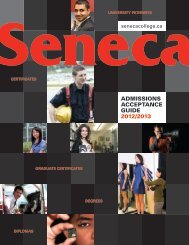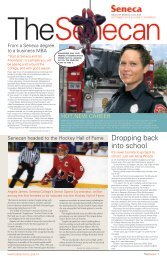2) Presence Build It And They Will Come - Seneca College
2) Presence Build It And They Will Come - Seneca College
2) Presence Build It And They Will Come - Seneca College
You also want an ePaper? Increase the reach of your titles
YUMPU automatically turns print PDFs into web optimized ePapers that Google loves.
priority of this <strong>College</strong> has always been, in a word, accessibility…that a<br />
student…real or potential, day or night… should never be unaware of <strong>Seneca</strong><br />
or what it does, should never have to agonize over whether <strong>Seneca</strong> is near<br />
enough to attend or whether <strong>Seneca</strong> has enough room, enough hardware,<br />
enough instructors or whether one can be allowed in to <strong>Seneca</strong> <strong>College</strong> for at<br />
least one fair chance.<br />
In the very first state-of-the -college report, jointly authored by the president<br />
and the Board chair, the principal expression of concern, gravely and<br />
passionately articulated, had to do with how many qualified and needy<br />
students were already being turned away by reason of a paucity of space and<br />
suitable facilities. Thirty years later, as the third <strong>Seneca</strong> president closed out<br />
almost a decade of change and development, his final and most eloquent<br />
pleas were for more space, more buildings, more renovations, more facilities<br />
and equipment for an ever-rising tide of student applications and further<br />
approvals to go where the students were and to bring them education and<br />
training from <strong>Seneca</strong>.<br />
i) The Sixties: From Cardboard Box to Cowie’s Factory to Finch<br />
(1) In Quest of a Permanent Site<br />
Consistent with Department of Education Regulations from the very start,<br />
<strong>College</strong> Boards were intended to function through Standing Committees,<br />
each of these to be responsible to the board for one or more areas of policymaking.<br />
Although some colleges enjoyed the efforts of a number of such<br />
committees (Finance, Property, Faculty and Student Affairs, Executive or<br />
Management Committees), the <strong>Seneca</strong> Board had very early struck two<br />
which would cover a multiplicity of services each. These were the Operations<br />
Committee, chaired by M. Grace Carter (covering “internal” operations of the<br />
new college (appointment of staff and faculty, relations with faculty and<br />
student organizations and the like) and the Administration Committee,<br />
chaired by Edmund C. Bovey (dealing with matters external to the strictly<br />
educational functions of the college, such as finance, physical facilities and<br />
the maintenance of the physical plant, together with all contracts associated<br />
with these functions in the very early days of the college).<br />
Naturally, as the college matured and policies and processes became<br />
routinized and highly specialized staff came to be recruited, these<br />
committees would alter their focus and would phase out of some of these<br />
functions. But in the very beginning they worked overtime to set the <strong>Seneca</strong><br />
stage in these designated areas. <strong>And</strong>, no responsibility consumed quite so<br />
much time as the search for a property optimally suited to <strong>Seneca</strong>’s needs,<br />
its auspicious futures, its requirements of size and access and its<br />
determination to serve the community. To this day, Grace Carter takes pride<br />
in the exhaustive search and endless interviews that led to recruiting a staff<br />
and faculty that would carry the unique and ambitious objectives of <strong>Seneca</strong><br />
into the 70’s and, in so many instances, into the millennium. But the hunt for<br />
105




